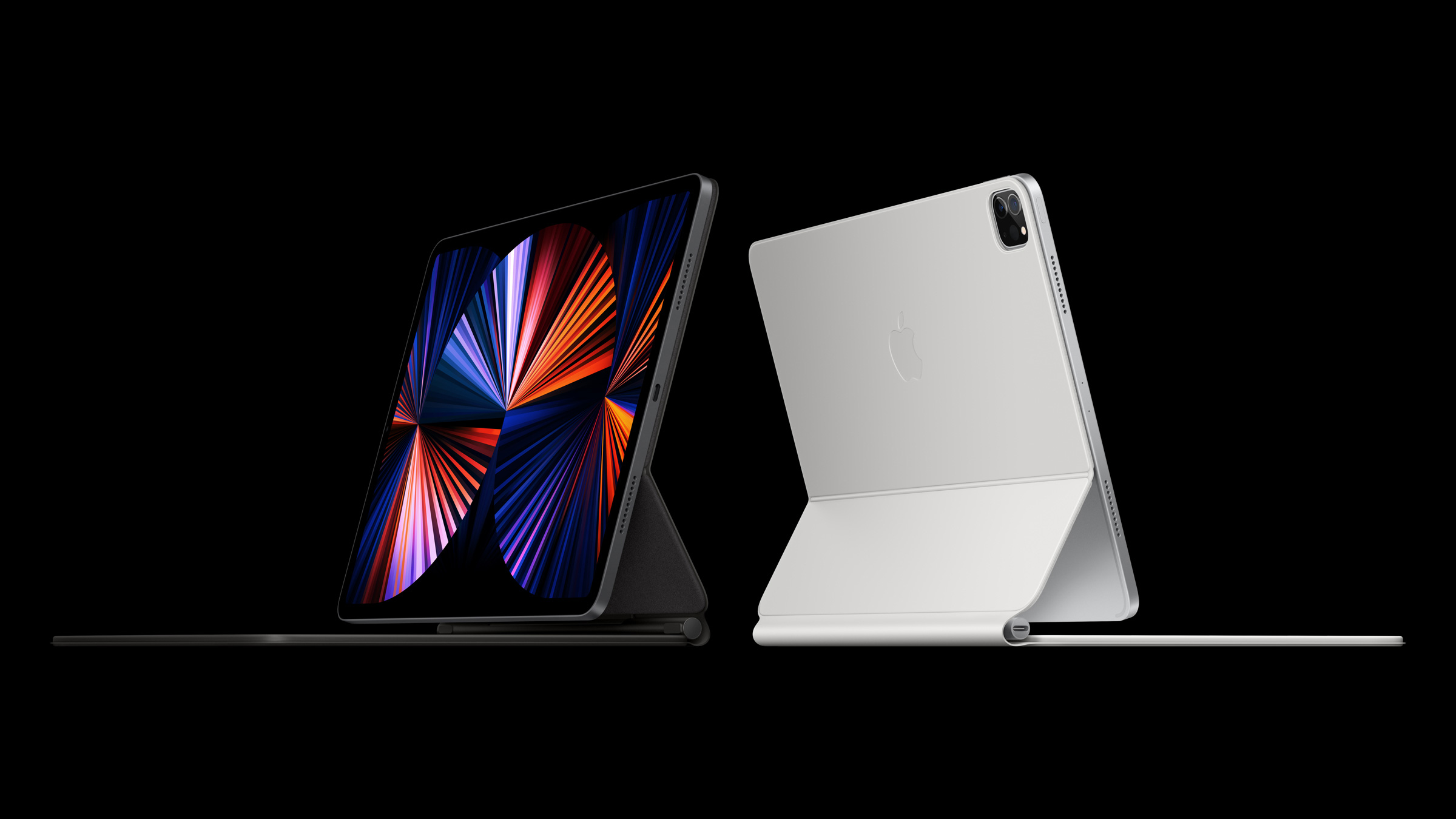I’m excited about the new iPad Pros, but the new 24” iMac took my breath away. I’ve long wanted Apple to return to the vivid colors of past Macs but wasn’t convinced the company would go that direction. Leading up to today’s event, mockups of iMacs in the pale color schemes of the iPhone 12 circulated. Today, however, Apple took the iMac in a wholly different direction with bright, saturated colors on the back of the new computer and paler hues on the front.
Posts tagged with "featured"
Apple Shows Off New M1 iMacs in Beautiful, Vibrant Colors
New iPad Pros Announced with the M1 Chipset, Thunderbolt, 5G, New Cameras, and a Liquid Retina XDR Display on the 12.9” Model
Apple today announced all-new iPad Pros featuring the same M1 chip found in the company’s latest Macs along with several other new features, including a Thunderbolt-compatible port, 5G connectivity on cellular models, updated cameras, and on the 12.9” model, a Liquid Retina XDR display that shares many of the specs as the company’s Pro Display XDR.
Apple Announces Online Media Event for April 20, 2021
As first confirmed by Federico on Twitter, Apple has announced a media event for April 20, 2021 at 10:00 am Pacific. The event will be held online only.
In an unexpected twist, the date of the event was leaked by Apple’s digital assistant Siri as reported overnight by MacRumors. When asked about the date of the next Apple event, Siri responded that it would be April 20th at Apple Park.
Based on changes coming with iOS 14.5, Apple is expected to introduce AirTags for tracking personal items, which is expected to work like the third-party Find My network devices announced last week. There has also been widespread speculation that the company will introduce new iPad Pros, and with the recent discontinuation of the iMac Pro, we may see new M1 Macs too. In addition to hardware, Apple will likely make iOS and iPadOS 14.5, watchOS 7.4, tvOS 14.5, and macOS 11.3 Big Sur updates available soon after the event.
Apple Announces That WWDC 2021 Will Be Online-Only Again from June 7 - 11
Apple has decided to make WWDC an online-only event again for 2021, which is no surprise given the on-going global pandemic. Before going online-only last year, WWDC was held at the San Jose McEnery Convention Center in San Jose, California, from 2017 - 2019. The event has been scheduled for June 7-11, 2021. Submissions for the Swift Student Challenge are open now through April 18th.
In a press release issued by the company today, Susan Prescott, Apple’s Vice President of Worldwide Developer Relations and Enterprise and Education Marketing said:
We love bringing our developers together each year at WWDC to learn about our latest technologies and to connect them with Apple engineers. We are working to make WWDC21 our biggest and best yet, and are excited to offer Apple developers new tools to support them as they create apps that change the way we live, work, and play.
Although there are benefits to an in-person event that cannot be replicated online, last year’s WWDC was widely considered to be a success. Apple released dozens of excellent videos about its latest APIs and conducted online lab sessions for developers that received high marks from participants. Although Apple hasn’t released details about this year’s format yet, it’s a safe bet that it will be similar to 2020.
I miss in-person WWDC a lot. Last year’s online version was excellent, but it’s impossible to replace the chance to get together with friends who I often only see at WWDC and meet with the developers whose apps we write about all year long. I expect there’s a chance that even after the pandemic recedes, WWDC will remain online-only, but I sure hope not.
Of course, MacStories readers can expect the same kind of comprehensive WWDC coverage we do every year. In 2020, we tried a few new things that worked well, and we’ll continue to experiment again this year, so stay tuned.
20 Years Ago, Mac OS X Set the Stage for Today’s Apple
It’s hard to believe that it’s been two decades since Mac OS X was released. I wasn’t a Mac user in 2001, but as a tech fan, I followed the release of OS X and the later switch to Intel closely, which was what finally convinced me to buy my first iMac.
Today, with Mac OS X gone and Intel chipsets not far behind, I thought it would be fun to look back at OS X and the transition to it compared to the recent switch to macOS 11 Big Sur. I started by watching Steve Jobs’ introduction of Mac OS X at Macworld Expo in 2000, which was a perilous time for the Mac. The company was just two and a half years into Jobs’ return as iCEO and had recently filled out its simplified product grid, adding the iBook to the iMac, Power Mac G4, and PowerBook lineup.
Downtime Organizer Sofa Adds Apps, Audiobooks, Board Games, Deeplinking, Backups, and More Themes
Sofa is a terrific downtime organizer. Since its release, the app has seen frequent updates that have added features and refinements that make it an excellent one-stop destination for collecting media you want to enjoy later. We’ve covered the app before, so I won’t revisit its core functionality here, but if you’re new to the app, be sure to check out our previous reviews for more details.
The headline feature of Sofa’s latest update is the addition of apps, audiobooks, and board games to the lineup of media it can track. I’m especially pleased to see that iPhone, iPad, and Mac apps have been added to Sofa. I’ve long considered trying new apps as a form of entertainment. Even poking around productivity apps that most people would consider ‘work’ apps is fun for many people.
The addition of apps is timely given the trend towards subscription-based apps with free trials. If an app catches your eye, but it’s got a relatively short free trial period, you can drop it into Sofa to try later when you can make the most of the trial. The addition of apps also provides a way to track games on Apple’s platforms that weren’t always available in Sofa’s videogame category. However, the change also means that you may have to search for an iOS game in a couple of different places at times.
First Impressions: Kensington’s StudioDock Aims to Turn Your iPad Pro into an Expandable Desktop Workstation
Nearly a year ago in the middle of the first wave of the COVID-19 pandemic here in Italy, I published an article that would turn out to feel obsolete in less than a month: in my Modular Computer story, I detailed my experiments with various accessories for the iPad Pro and how the device was capable of filling different roles in my computing life thanks to the Smart Keyboard Folio, an external 4K monitor, Apple’s Magic Trackpad, and a set of kickstands. About a month later, my laptop setup for the iPad Pro was upended by the arrival of Apple’s Magic Keyboard; as a result of the Magic Keyboard’s floating design and integrated keyboard/trackpad approach, I’ve preferred using my iPad Pro in laptop mode more often, even when I’m sitting at my desk.
A year later, Italy is going through the so-called “third-wave” of the pandemic (with a terribly mismanaged vaccine rollout and, for whatever reason, a different government) and I’ve spent the past 24 hours testing Kensington’s long-anticipated StudioDock, a $400 docking station1 that aims to turn the iPad Pro into a desktop workstation with support for display rotation, expansion via USB-C, USB-A, and SD card slots, and integrated Qi charging for iPhone and AirPods. And just like last year, I find myself torn between appreciating the potential of this product and concerned about its timing given rumors of an impending iPad Pro refresh just around the corner.
A day of usage2 isn’t enough time to evaluate this kind of product and its long-term impact on an iPad user’s daily workflow. I feel particularly uncomfortable giving MacStories readers any sort of buying advice here because of the price tag (again, $400 for the StudioDock version I tested) and the short amount of time I was able to spend with the accessory. For these reasons, I’ll try my best to focus on what the StudioDock is, what I like about it in the context of modularity and converting the iPad Pro into something it’s not (or, at least, something Apple probably didn’t anticipate), and a few features it’s missing.
Adobe Fresco: A Fun and Powerful iPad Drawing and Painting App For Pros and Novices
I’m not an artist by any stretch, so when I started poking around Adobe’s Fresco, the drawing and painting app for the iPad and iPhone, I approached the app with trepidation. I shouldn’t have.
Fresco is undeniably a ‘pro’ iPad app. The app has a deep set of sophisticated features and integrations with Adobe’s other Creative Cloud apps and services. However, the app is also designed to scale with its users, meeting them where they start and growing with them, whether they are absolute beginners or seasoned pros.
Adobe accomplishes this in a couple of ways. The first is with Fresco’s business model. I’m sure many people who see an app of Fresco’s caliber assume it must be part of an expensive subscription, but it’s not. The app is free, and although there are benefits that only come with a Creative Cloud subscription, their absence from the free version of the app doesn’t detract from its core experience. You can go a long way with the free version, which makes it excellent for beginners and a good way for Adobe to attract new users.
Free is powerful, but it only goes so far. The second reason Fresco works for a broad spectrum of users is the app’s design. From the spot in the app to which every user is taken when they open their first canvas to the many ways to learn and draw inspiration from experienced users, Fresco’s thoughtful design provides a focused approach to drawing and painting that works for users at all levels.
Ultimately, it’s Fresco’s design that convinced me that this was a review I should write. I’m as guilty as the next person of assuming apps like Fresco are only for pro users. I’ve been pleasantly surprised to find that that’s not true for Fresco. So let’s dive into what makes Fresco such a good place to start if you want to try drawing and painting with your iPad and iPhone.
Nudget Review: Budgeting Made Simple
Nudget1 is a budgeting app designed to streamline the daily input of expenses. Developer Sawyer Blatz created a gorgeous and extremely efficient interface to make budgeting feel light and fun. With my beloved bank Simple closing this year, I’ve been looking for new solutions for keeping track of my finances. Over the last couple weeks I’ve worked with Nudget full-time, and the experience has been rewarding.
Getting Started
As is the case with any budgeting app, you’ll need to put in a bit of work up front to get started with Nudget. When you first open the app it will prompt you to input your after-tax income and recurring expenses. Nudget uses this data to craft a simplified budget for you. Budget-wise, the app isn’t doing anything too fancy. Each budget consists of three categories: recurring expenses, spending money, and savings. These categories are shown as large cards in Nudget’s ‘Budget’ tab, and you can tap each one to edit it.










